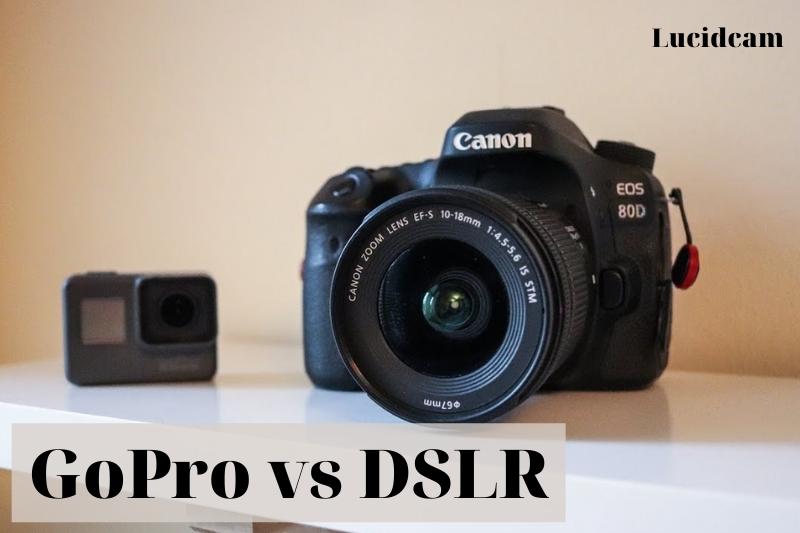- HanJin
There are so many great cameras available that it can be difficult to choose the right one. Two of the most sought-after cameras are GoPro and DSLR. Which one is best for you? Here is the detailed comparison between GoPro vs DSLR to help you decide which is right for your needs and what you want for your travel photos.
Table of Contents
- 1 GoPro vs DSLR
- 1.1 GoPro vs DSLR: Which Is The Best Option?
- 1.2 Video Formats
- 1.3 Video Quality
- 1.4 Stabilisation
- 1.5 Video Stabilization
- 1.6 Size and Weight
- 1.7 Lenses
- 1.8 TimeLapse Video
- 1.9 Live-streaming
- 1.10 Resolution and framerate
- 1.11 Versatility and Accessories
- 1.12 Image Quality
- 1.13 Waterproof (Case or Not)
- 1.14 Easy Use (For Beginners)
- 1.15 Control/Settings Available (For The Pro).
- 1.16 Conclusion
GoPro vs DSLR
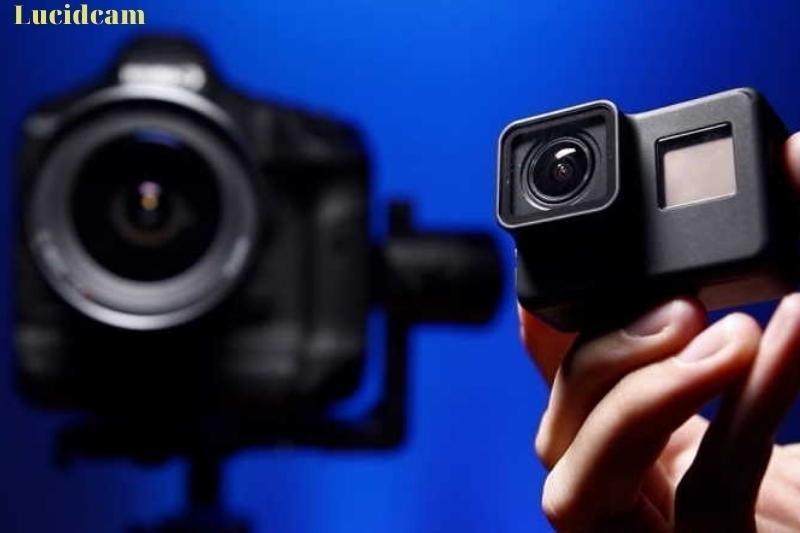
GoPro vs DSLR: Which Is The Best Option?
GoPro Hero 9
- Image Formats: JPEG & Raw
- Sensor Size 20MP
- ISO Range: Auto, 100-3200
- Bursts up to 25 photos/second
GoPro Hero 5 Session (Low-End)
- Image Formats: JPEG
- Sensor Size: 10MP (364×2736).
- ISO Range: Auto, 100-800
- Bursts up to 30 photos/second
Nikon D7200 (Mid Range)
- Image Formats: JPEG & Raw
- Sensor Size: 24MP (6000×4000).
- ISO Range: Auto, 100-25600
- Bursts: 6 photos/second
Nikon D3400 (Low End)
- Image Formats: JPEG & Raw
- Sensor Size: 24MP (6000×4000).
- ISO Range: Auto, 100-25600
- Bursts: 5 Photos/second
Video Formats
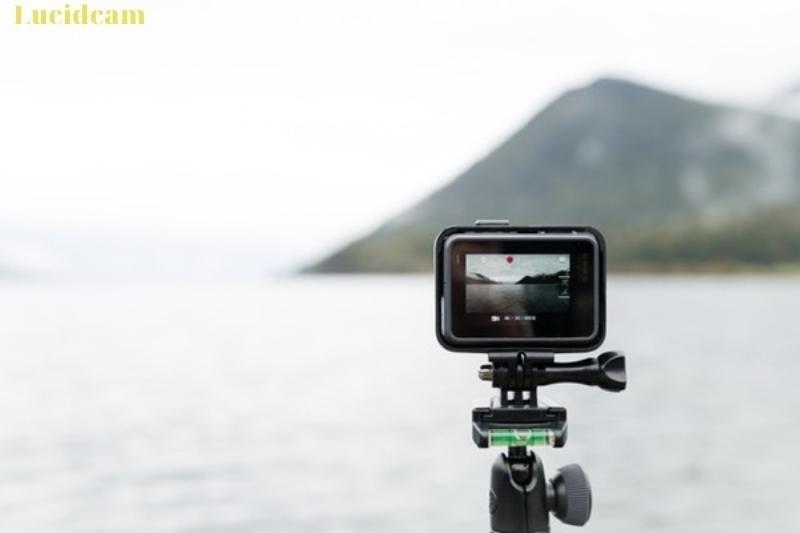
GoPro Action camera is all about video. It has been designed to take action video with a small camera. This is why so many people love it as a travel camera.
The table below shows that the GoPro offers a wide range of video formats and frame rates. This is crucial when you want to capture the action.
Low frame rates will result in less detail and more work (slowing down) in post-production. It is not surprising that they will increase frame rates (fps) to 120 for some formats.
DLSRs, on the other hand, rarely reach the 4K range (although that is changing recently) and only 60 fps which is not bad but will be a problem for action-lovers!
You will need to spend a lot of money to get a DSLR camera that can create great videos. Unless you’re comfortable with 1080p at 60fps frame rates,
GoPro Hero 9 (High-End)
Formats:
5K – 30/25fps, 4K – WideWide Lens @ 60, 30, 24 fps- SuperView Lens @ 30, 24 fps- Linear Lens @ 60, 30, 24 fps2.7K – WideWide Lens @ 120, 60, 30, 24 fps- SuperView Lens @ 60, 30, 24 fps- Linear Lens @ 60, 30, 24 fps- Narrow Lens @ 60, 30, 24 fps1080p – WideWide Lens @ 240, 120, 60, 30, 24 fpsSuperView Lens @ 120, 60, 30, 24 fpsLinear Lens @ 120, 60, 30, 24 fpsNarrow Lens @ 60, 30, 24 fps
GoPro Hero 5 Session (Low-End)
Images Formats JPEG
- 4K @ 30, 25 FPS
- 2.7K (2704×1520) @ 48. 30, 25, 24, fps
- 1440p (1920×1440) @ 60, 50, 30, 25, 24 FPS
- 1080p (1920×1080) @ 90-60, 50, 30, 25, 24, fps
- 960p (1280×960) @ 100-60, 50, 30, 25, 25 fps
- 720p (1280×720) @ 120-60, 50, 30, 25, 25 fps
Nikon D7200 (Mid Range)
Formats:
- 1080p (1920×1080) @ 60, 50 & 25, 24, fps
- 720p (1280×720) @ 60,50 fps
- 640×424 @ 30 fps
Nikon D3400 (Low End)
Formats:
- 1080p (1920×1080) @ 60fps (1080 FullHD)
Video Quality
As with still photography, the best video system for you will depend on what subject matter you are shooting. The GoPro’s larger size and the Hero5 Black’s advanced features will make it a better choice.
If you have been using a DSLR for a while, this may seem like heresy. But we are serious!
Let’s just go through the list of things that every videographer should do before shooting. We’re sure you’ll agree with us that a GoPro is a better choice for video than a DSLR.
Stabilisation
Recent years have seen rapid advancements in in-camera image stability technology. Many interchangeable lens cameras now offer 5-axis image stability, which allows photographers to capture handheld images at shutter speeds previously unimaginable.
However, despite all these advancements, it is still the best way to get professional-looking, smooth video footage.
GoPro’s built-in digital imaging stabilization gives your image a slightly cropped appearance to give it stability. It’s improved over time. GoPro’s enhanced EIS HyperSmooth, which is basically GoPro’s in-camera EIS with a bit more headroom, allows for greater cropping to the image to allow for electronic image stabilization. It works at 4K with a 16/9 aspect ratio, but not at 4K with 4:3.
Video Stabilization
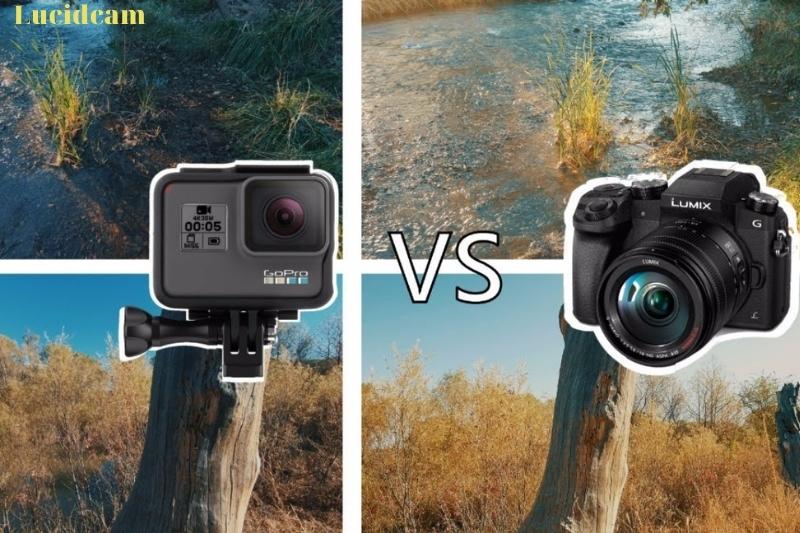
You will need some stabilization if you plan to film a video of the movement.
You’ve probably seen enough “shaky video” to last a lifetime. This is why manufacturers are working hard to solve this problem.
Built-in stabilization can be achieved with the GoPro (software-based/EIS). This has been greatly improved since they started making it. You can see Hero 8’s HyperSmooth 2.0 version in action
You will need a gimbal to get the best results or a very expensive camera with built-in stabilization.
This comparison shows that neither DSLRs have it. You usually have to spend more money. In this respect, GoPro is the winner.
Size and Weight
Although this is a fairly obvious point, it’s worth noting: Size and weight.
GoPros are smaller than a standard DSLR, and that brings many advantages.
Portability (they can be carried around easily, but you will need accessories to make it happen).
They can be placed almost anywhere. This is why they are so popular among videographers – hidden, on people/moving objects, etc.
It’s easy to carry: You don’t need to take a lot of weight. A GoPro can be carried in your bag or pocket: no weight, no size, no fuss.
This is approximately the same size as the difference shown in the images. These specs are listed further down.
Nikon D3400
There are huge differences in the weights of both GoPros and Nikons. They weigh between 2.5 – 4.2 oz and 0.9 to 1.5 lb, respectively. You should think twice about taking your DSLR with you on a day. They are more suited for professional photographers/serious amateurs.
GoPro Hero 8 (High-End)
- Weight: 5 oz/142g (with battery).
- Dimensions: 66.3×48.6×28.4mm
GoPro Hero 5 Session (Low-End)
- Weight: 2.6 oz / 73 g
- Dimensions: 1.49×1.49×1.42 inches (36.7 x 37.9×36.1mm).
Nikon D7200 (Mid Range)
- Weight: 1.49 lb
- Dimensions: 5.35×2.99×4.21 inches (135.9×75.9×106.9mm).
Nikon D3400 (Low End)
- Weight: 0.87 lb
- Dimensions: 4.88×2.97×3.86 inches (124×75.4x98mm).
Lenses
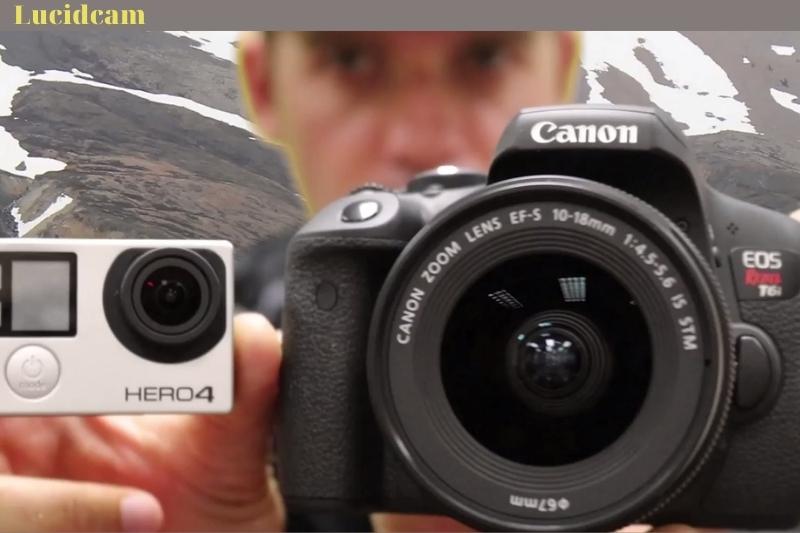
The lens situation is another area worth mentioning (which extends the Image Quality discussion).
You won’t get the same quality images from a DSLR with the GoPro’s small/fixed lens.
A DSLR lens can be larger, allows for more light (as well as having a 24MP sensor), and offers more options. DSLRs can be equipped with interchangeable lenses that allow for a wide range of shooting options.
A big zoom can be added to your camera, which can be great for taking photos from faraway or detail shots (which is impossible with a GoPro).
Wide-angle lenses can be added to your GoPro, which is great for action and landscapes.
You can get low F-stop lenses for your DSLR. This allows you to create the “blurred background” effect most commonly used in portraits. You can see the blurred background in the black-and-white image here. Cool vintage lenses, such as the Helios, can be used to add atmosphere to your photos.
It’s impossible to do that with a GoPro. You can use software that simulates the effect, but it is not the same. ).
This detailed post will show you the Nikon Lens Options.
There are a few wide-angle options available on the GoPro. Wide-angle shots were the only option for GoPros. This was to get the best view possible while on the go. The GoPro Hero5 now has a wide range of lenses, from linear to wide (which is their version for not causing distortions like when you use a GoPro with a really wide-angle lens).
These lenses are not dedicated lenses but options within the lens. This almost always leads to a better result and a high-quality image producer.
TimeLapse Video
Many DSLRs, from entry-level models such as the Canon EOS 250D/SL3 to flagship models such as the Nikon D850, have built-in timelapse modes. You also have the option, especially with Nikon cameras, to save your time-lapse sequence in a batch of images or as one movie file that automatically creates a video.
You might prefer to have a set of images rather than the camera creating a time-lapse automatically. You have more control and can even remove frames that were lost by a child. A DSLR is very useful for this purpose.
You have four options when it comes to time-lapse with GoPro: TimeWarp video (video), TimeLapse Video (photo), Night Lapse Photo (photo)
TimeWarp, which is new to GoPro cameras starting with the Hero7 Black, is basically a timelapse setting. However, when combined with HyperSmooth, you get an ultra-smooth motion timelapse that’s just possible. TimeWarp, which is new to the Hero7 Black, is essentially a timelapse setting. However, when combined with HyperSmooth, you get an ultra-smooth motion timelapse that’s just possible.
Live-streaming
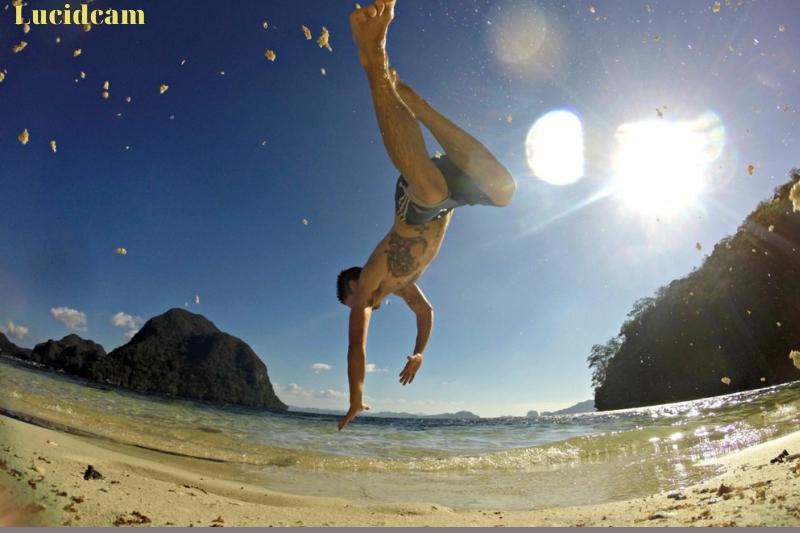
Live broadcasting is another advantage that GoPros have over DSLRs since the Hero7 Black. The app allows you to do this.
Once the live view is loaded, swipe down to activate it until you reach Live mode.
You can then log in to your YouTube or Facebook account to broadcast to the world.
Resolution and framerate
It might be surprising to you that the GoPro wins the DSLR vs. GoPro comparison. While many DSLRs can record HD and 4K video at 30fps, some mirrorless cameras can record 4K at 60fps. But the GoPro has been able to record this standard quality for a while now, and the company continues to raise the bar each year.
The Hero6 Black GoPro maintained the maximum resolution of 4K but increased frame rates to 60fps from 30fps and 1080p to 220fps. The headline frame rates for the previous generation were almost doubled by GoPro. Now, the GoPro Hero9 Black can record 5K at 30p or 4K at 60p. You also have the option to record 1440 at 120p, 1440 @ 120p, 1080 at 244p and 1540 at 120p. This is a remarkable range of options.
This allows you to create many different types of video, including slow-motion movies. These slow-motion movies slow down fast-moving sequences in stunning detail. This means that slow-motion footage can be filmed at a frame rate of 1 second and lasted for 8 seconds.
Versatility and Accessories
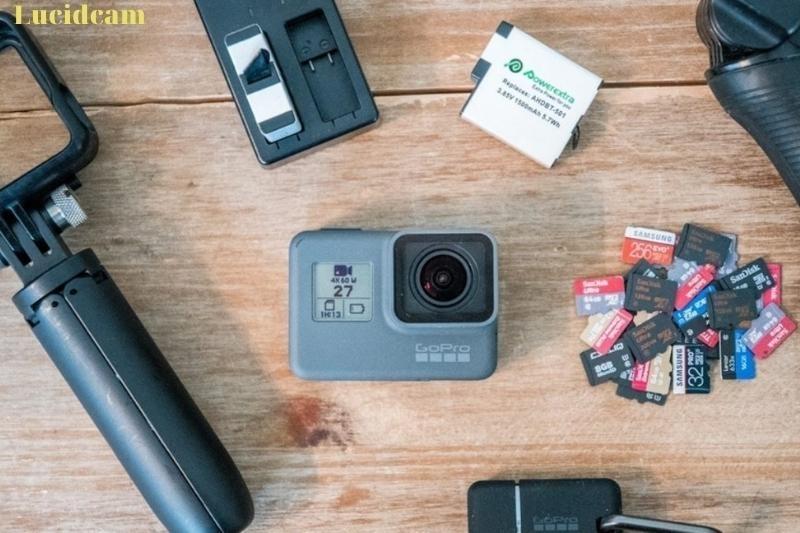
Mounts are a key part of the GoPro. This refers to being able to attach it to any object that moves or to be able to carry it around while you’re out and about doing sports, traveling, or just having fun.
Below is a list of mount kits that you can purchase from Amazon. The kit includes a head mount, chest mount, tripod, swivel, and lots of stickers for mounting on any object you desire. It also comes with a 3-piece handgrip for many different shooting and selfie options.
GoPro 3 Way Mount
A DSLR, on the other hand, is better suited for a traditional tripod or to be worn around the neck and used as a handheld.
You also care more about image quality, so it’s no surprise that lens filters are included to give you even better results. These filters can be simple UV filters or more complex ND and polarizing filters, depending on the situation.
Filter kits are also available on the GoPro, but they don’t have the same flexibility, options, or fit as DSLRs. You don’t have to worry about color corrections underwater with a DSLR.
External audio is generally easier for DSLRs than it is for smartphones. There are many options available for the GoPro. If you are looking for an external microphone for your GoPro, there are options such as lapel mics or attached mini-boom microphones.
Image Quality
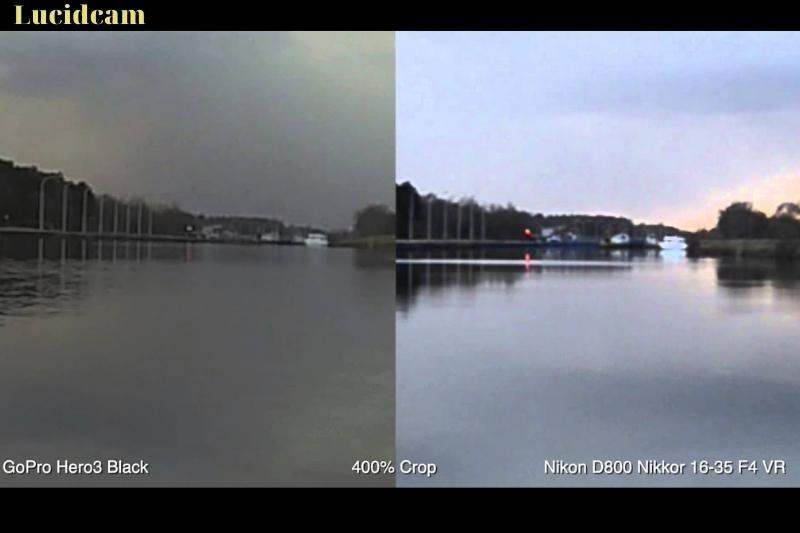
You can clearly see the differences between these cameras by comparing the GoPro Hero 8 with some Nikon DSLRs of high quality but reasonably priced.
The GoPro was designed and built as a video action camera, and capturing quality images is secondary. The GoPro sensor has half the size of Nikon DSLRs, so you can capture twice as much detail.
You will notice a significant difference in the lens quality (one is small, and one is big), which can result in stunning blurred backgrounds, such as those seen in portraits. This is difficult to compare as the lenses can only be changed with a DSLR, not the GoPro camera.
The ISO setting is another interesting measurement. DSLRs can go much higher and capture better images in low light. Although you may experience some image noise at the highest ISO setting (25600), the wider lens will allow you to shoot handheld with virtually no shake using a DSLR.
Waterproof (Case or Not)
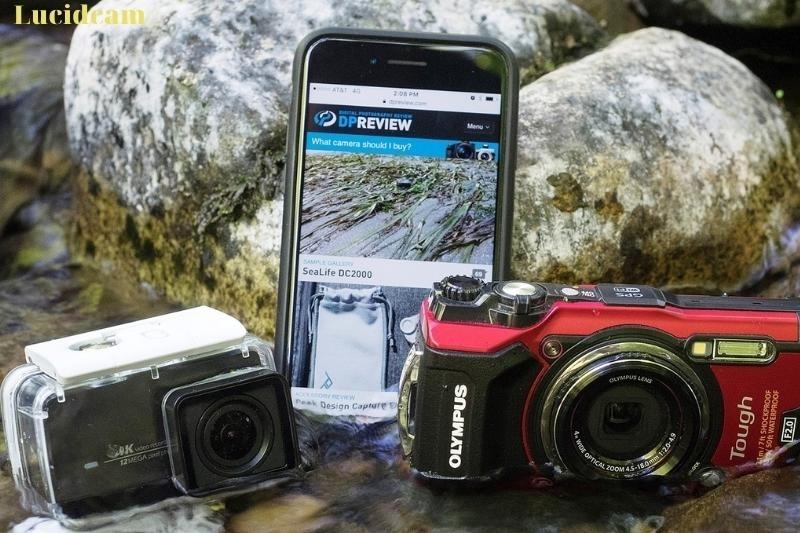
GoPro was created to be a waterproof camera. There is no competition.
It’s worth noting that the Hero5 (latest version as of 2017) is now waterproof down 33ft (10m), without the need for separate housing. It was waterproofed in previous versions, but you couldn’t control the camera from the screen.
GoPro housing allows you to go down to 196ft (60m)
DSLRs weren’t meant to be wet. They are very open and contain complex and sensitive electronics.
Manufacturers have attempted to resolve this problem, but it is hard because of their design.
To protect your device in watery situations (e.g., river, beach, rain), you can get a waterproof cover. Although they claim to be waterproof up to 16ft, I wouldn’t risk my life for a cover under 50 dollars.
Instead, serious photographers use underwater housing to protect their DSLR cameras.
This is a typical model for pros, and it costs around one and a quarter G. But again, this is for serious DSLR enthusiasts who have already spent thousands of dollars and still want that high-quality image.
Easy Use (For Beginners)
These cameras offer a variety of settings that make it difficult to know how to use.
The big question is, can you just take it out of its box and press GO? It is simple enough for beginners to grab the box and start using it.
It’s easy with the GoPro Hero9. You just need to press the big red button at the top to begin shooting. You must make sure that you are in either video or photo mode before you start shooting. This is the most difficult part. It’s easy to use the screen at the back to control everything.
A DSLR, on the other hand, looks much more complex when you consider all of its options.
On the plus side, it’s easy to just put it in Auto (or video), and you should be fine.
Although you will need to know a few additional buttons (focus, zoom, mode dial), it is not difficult.
The GoPro may have a slight advantage in that it is much simpler and less intimidating to use and requires only one button.
Control/Settings Available (For The Pro).
GoPro has attempted to offer a variety of settings for its cameras. They even have ProTune, which allows you to access more advanced features. You can adjust frame rates, wide-angle, color and audio corrections, etc.
The camera’s true purpose is to be an action camera with high-quality video resolutions, frame rates, burst modes, and time-lapse. It’s all about capturing motion.
Compared to a DSLR, you have less control and can’t do many things on the fly. You also need to read the menus.
You can take pictures with a DSLR:
- You can fine-tune your focus using the screen or the viewfinder.
- All lens and shutter options (shutter speed ISO, f-stop, shutter speed) can be changed
- You can easily change the modes and settings using the dials and buttons
- Add many high-quality filters to your stack and stack them
The GoPro is more like a set and then go. It is difficult to make changes as you go along with the GoPro because you must use the main button or screen (which you can do on DSLRs too, but they have dedicated dials/buttons).
The video settings of the DSLR are less than ideal as most models don’t have 4K and the frame rates that action photographers need. The DSLR excels in producing high-quality images and video, at least at 1080p, as I have already mentioned.
Conclusion
The type of travel and the type of photos you are taking will determine which best camera is for you. A GoPro is the best choice if you are an adventurer or backpacker who needs a small, portable camera. A DSLR is the best choice if you don’t move as often and still want to capture beautiful, clear landscapes or portraits of your travels, and it also gets a better image.
If you found this article useful, please help all GoPro users by sharing it with your friends.
